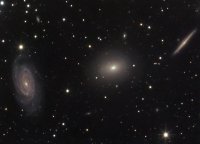Olbers' Paradox or Why is the sky dark at night?
In actual fact the question can be traced as far back as Kepler in 1610 and it was discussed by Halley and Cheseaux in the eighteenth century, but it was Obler who popularized it as a paradox in the nineteenth century.
I suppose we've all thought about it at some time and the answer's easy, the Sun's round the back; we're in the shadow, so there's no light. But wait a minute, if the Universe is static, infinite in extent, infinitely old and uniformly filled with stars, then the night sky should shine with the brilliance of the surface of a star. Whichever direction we look out into the night sky, eventually the line of sight should intercept a star. Obviously this is not the case; the night sky is black (or it would be if it were not for light pollution), there must be something wrong with our assumptions or our reasoning. This was the paradox posed by the Viennese astronomer Heinrich Olbers (1758-1840) in 1826.

We now know, or at least the accepted theory is, the universe is not infinitely old, it had a beginning, so stars and galaxies have only existed for a finite time. If we imagine a sphere centered on the Earth, then the surface of this sphere encloses what we call the observable Universe. Light from any source outside this sphere has not had time to reach us yet even if it started out immediately after the Big Bang.
We also now know, or again the accepted theory is, that the Universe is not static, it's expanding and in the observable Universe the stars and galaxies are receding but not receding faster than the speed of light, they are redshifted, so the photon energy is less and therefore the light from them is consequently not as bright.
Light from galaxies and stars is limited by their finite life and the finite speed of light. In other words many stars and galaxies have been born, lived and died already.
What about interstellar dust, would this not absorb and obscure starlight? Yes it would, but in doing so it would heat up and eventually shine as brightly as the stars so this idea is not feasible!
So there it is, we now know why the sky is dark at night, but I get the feeling that there are probably more questions than answers.
One interesting point to ponder when you are out observing. From the centre of our observable Universe one can see (with the best equipment) objects 15 billion light years from Earth. An observer at the surface of that sphere would have an observable Universe of radius 15 billion light years so he/she/it would be able to see objects that would be 30 billion light years from Earth and an observer at the surface of that sphere…